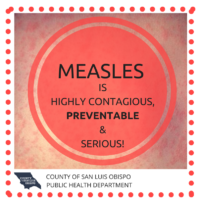SLO County resident contracts measles
January 11, 2017
 San Luis Obispo County Public Health officials have confirmed a local resident has contracted measles. The patient is an adult who was not vaccinated against the disease and who came in contact with international travelers over the holidays, according to the public health department.
San Luis Obispo County Public Health officials have confirmed a local resident has contracted measles. The patient is an adult who was not vaccinated against the disease and who came in contact with international travelers over the holidays, according to the public health department.
The individual began displaying symptoms of measles on Jan. 3. Then on Sunday and Monday, the person went to the Twin Cities Community Hospital emergency room.
Twin Cities in Templeton is currently in the process of verifying that hospital staffers exposed to the patient have been fully vaccinated against the virus. Officials are also contacting hospital patients and visitors who were exposed to the patient
The measles patient is cooperating with public health investigators.
“Measles is a serious disease that can be easily prevented,” SLO County Deputy Health Officer Dr. Christy Mulkerin said. “Vaccination is the best way to protect against measles. Two doses of the measles, mumps and rubella vaccine are approximately 97 percent effective at preventing disease in exposed persons.”
The SLO County measles case follows a recent outbreak of the disease in Los Angeles County, as well as one person contracting the virus in Santa Barbara County. It is currently unknown if those cases are related.
Measles spreads through coughing or sneezing. Measles symptoms generally appear about seven to 14 days after a person is infected.
The infected person typically develops a high fever, cough, runny nose and red, watery eyes. Two or three days later, tiny white spots may appear inside the mouth.
A rash consisting of tiny, red spots then breaks out. The rash starts on the face and spreads to the rest of the body.
Measles patients are typically contagious for about nine days, including the four days prior to the rash breaking out.
The measles virus can cause serious complications, especially for young children. Measles can lead to pneumonia, encephalitis — swelling of the brain — and death.
It is not very common for United States residents to contract the virus because most people in the country are vaccinated. But, measles is still common elsewhere in the world, including in many countries in Europe, Asia, the Pacific and Africa. Every year, unvaccinated Americans contract measles while abroad, and they bring the disease into the United States, where it spreads to others.
Public health officials say it is very important for people to be up to date on vaccinations, particularly before traveling abroad. Those who have had measles in the past or who have been vaccinated against the disease are considered immune by Center for Disease Control and Prevention standards.






The comments below represent the opinion of the writer and do not represent the views or policies of CalCoastNews.com. Please address the Policies, events and arguments, not the person. Constructive debate is good; mockery, taunting, and name calling is not. Comment Guidelines